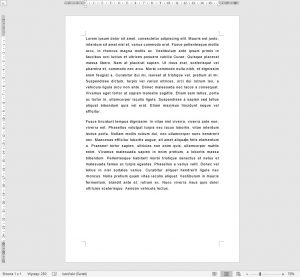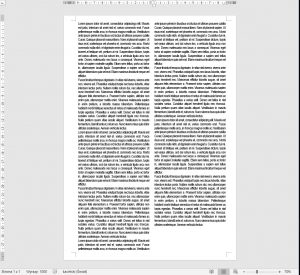We often receive texts with a client’s note that “there’s only five pages, I want the translation done by tomorrow morning.” However, it turns out that these “five pages” are written over from margin to margin in small font size, with narrow line spacing, and, on top of that, in columns. What do we do then?
How to calculate translation size?
As you can see below, apparently these are similar two A4 pages filled with “Lorem ipsum”. One page has double line spacing and expanded font, while the other is quite the opposite. The text is in columns with narrow page margin, narrow line spacing, and dense font. Are they priced the same? Of course, they aren’t. The page on the left contains text of one standard page, and the other: four standard pages.
Let’s take a look at this important concept that affects the cost and delivery date of translation.


What is a standard page?
“Standard page” is an established way to calculate how much text is contained in a file. It helps estimate the time needed for translation. A standard page is determined by counting either the number of characters including spaces, or the number of words.
The former method has been widely used in Poland for many years, however, due to Western, Anglo-Saxon influences, the latter method has gained strong footing recently.
In terms of characters, there are several sizes of standard pages. The most common is 1800 keystrokes including spaces and this number was established when typewriters were still in use. Another relatively common number is 1600 keystrokes including spaces. It’s used by large translation companies. The last number is 1125 keystrokes including spaces. It’s applied by sworn translators as per governmental authorities’ requirements.
What about word count?
The word count method has been used in Poland for some time now, although it’s less popular than the character count. In this approach, a page has 250 words. This is a standard widely used in Great Britain and the USA. In this case, a standard page includes that number of words with double spaces. It should be noted here that a “word” means anything that stands between two spaces or a space and a punctuation mark. This means that all articles or prepositions are also counted as separate words.
How do we do page count?
At Translatorion, we use the traditional Polish standard, namely 1800 keystrokes, including spaces, of the source text in Polish. In the case of source texts in English, we use the 250 words per page standard. We refer to the source text as the basis, because it makes the quotation faster and the client knows the total cost before official order.
Sometimes it is necessary to count the characters in the target text, though. This happens when the text is handwritten, in non-editable PDF files, or sent as photos of documents whose quality is too low to be processed effectively with an OCR software. We provide an estimate offer and the exact number is counted on the basis of the translated text.
How to count characters, words, and pages?
A rough estimate can be made with an adequate function in a text editor. I assume that all advanced text editors have this feature. In Microsoft Word, you can find this in the Review tab, then Word Count, which shows, among other things, the number of words and characters with or without spaces. In Google Docs, this function can be found in Tools and then Word Count. However, this is just an approximation for the purposes of translation, therefore we use the Analysis feature in Wordfast.
This feature counts the exact number of characters (or words) which are really translated as it ignores, e.g., characters in bullet point or numbered lists. Some old CATs didn’t include segments that contain only numbers, however new versions do count those. The argument for not including them is that these are just numbers, there’s nothing to “translate”, they just need to be copied to the target text.
However, a stronger counterargument is that in the case of such language pairs like English and Polish numbers do require attention. The Polish and English conventions for writing numbers are different. For example, in English we write 12,345,678.9 but in Polish it would be 12 345 678,9 or 12.345.678,9. Because translators need to check whether a given number requires the change in the convention and, if necessary, make such change, it is assumed that segments with numbers only are also counted towards the total number of characters or words.
How to calculate the cost of translation?
Once we’ve analysed the text, we convert the number of characters (or words) into pages by dividing the number by 1800 (or 250), and we round it. This way we have a fairly accurate number of pages to prepare the final quotation. All this is settled when we prepare the terms for particular translation.
However, calculating the number of pages and multiplying it by the rate does not mean that the translation of the text will cost exactly that. Sometimes additional services are necessary, e.g. creating an editable file with OCR software or express translation. Also, the price may be higher if a specialised text is to be translated.

Whatever text may come along, we always put our best effort to calculate meticulously the number of pages as fast as possible and send a quotation. Find out for yourselves!
Paweł


